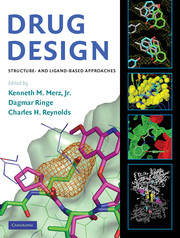Book contents
- Frontmatter
- Contents
- Contributors
- Preface
- DRUG DESIGN
- 1 Progress and issues for computationally guided lead discovery and optimization
- PART I STRUCTURAL BIOLOGY
- 2 X-ray crystallography in the service of structure-based drug design
- 3 Fragment-based structure-guided drug discovery: strategy, process, and lessons from human protein kinases
- 4 NMR in fragment-based drug discovery
- PART II COMPUTATIONAL CHEMISTRY METHODOLOGY
- PART III APPLICATIONS TO DRUG DISCOVERY
- Index
- References
3 - Fragment-based structure-guided drug discovery: strategy, process, and lessons from human protein kinases
from PART I - STRUCTURAL BIOLOGY
Published online by Cambridge University Press: 06 July 2010
- Frontmatter
- Contents
- Contributors
- Preface
- DRUG DESIGN
- 1 Progress and issues for computationally guided lead discovery and optimization
- PART I STRUCTURAL BIOLOGY
- 2 X-ray crystallography in the service of structure-based drug design
- 3 Fragment-based structure-guided drug discovery: strategy, process, and lessons from human protein kinases
- 4 NMR in fragment-based drug discovery
- PART II COMPUTATIONAL CHEMISTRY METHODOLOGY
- PART III APPLICATIONS TO DRUG DISCOVERY
- Index
- References
Summary
INTRODUCTION
The experimental roots of fragment-based drug discovery can be found in the work of Petsko, Ringe, and coworkers, who were the first to report flooding of protein crystals with small organic solutes (e.g., compounds such as benzene with ten or fewer nonhydrogen atoms) to identify bound functional groups that might ultimately be transformed into targeted ligands. The concept of linking fragments together to increase binding affinity was described as early as 1992 by Verlinde et al. Computational screening of fragments, using tools such as DOCK or MCSS, was also described in the early 1990s. Pharmaceutical industry application of fragment screening began at Abbott Laboratories, where Fesik and coworkers pioneered “SAR by NMR” (structure/activity relationship by nuclear magnetic resonance). In this spectroscopic approach, bound fragments are detected by NMR screening and subsequently linked together to increase affinity, as envisaged by Verlinde and coworkers. Application of x-ray crystallography to detect and identify fragment hits was also pursued at Abbott.
Fragment-based drug discovery has now been under way for more than a decade. Although Fesik and coworkers popularized the notion of linking fragments (as in their highly successful BCL-2 program), tactical emphasis appears to have largely shifted from fragment condensation to fragment engineering (or growing the fragment) to increase binding affinity and selectivity. Various biotechnology companies, including SGX Pharmaceuticals, Astex, and Plexxikon, have recently demonstrated that fragment-based approaches can indeed produce development candidates suitable for Phase I studies of safety and tolerability in patients (www.clinicaltrials.gov).
- Type
- Chapter
- Information
- Drug DesignStructure- and Ligand-Based Approaches, pp. 30 - 40Publisher: Cambridge University PressPrint publication year: 2010
References
- 1
- Cited by



